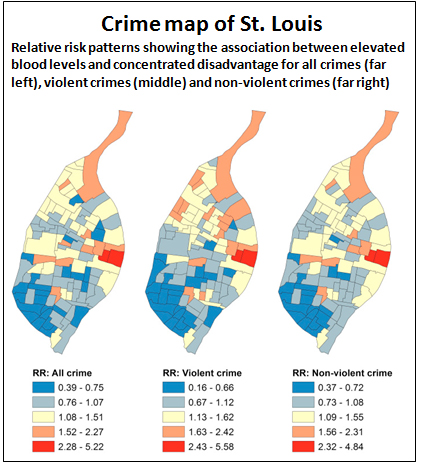A team of researchers has released a new study investigating the association between childhood lead exposure and later crime rates in St. Louis. Unlike most previous studies, it uses census tracts in order to get the most detailed possible  look at subpopulations within the city. Their conclusion: “We uncovered a relatively strong effect of lead on behavior, especially violent behavior.” This was true even after controlling for other variables that affect crime rates:
look at subpopulations within the city. Their conclusion: “We uncovered a relatively strong effect of lead on behavior, especially violent behavior.” This was true even after controlling for other variables that affect crime rates:
It is important to recognize that for the current analyses, the effect of lead remained a robust predictor of crime using methods capable of accounting for spatial correlations, and above and beyond the possible confounding influence of concentrated disadvantage.
….Because sociologists (as well as other macro-level scholars) have continued to highlight the primacy of concentrated disadvantage (as well as other macro-level variables) in predicting societal adversities (including crime), other relevant predictors such as lead often receive short shrift in the literature as well as less consideration when the topic shifts to policy initiatives. This is less than ideal because lead has emerged consistently, both in the current sample as well as others, and at the macro- and individual-level, as an apparent potent predictor of adverse behavior. Continuing to myopically focus on traditional forms of “social” adversity such as poverty runs the risk of downplaying more important behavioral predictors.
The authors are appropriately cautious about interpreting their findings. This is yet another ecological study, which compares populations across time, and that means it’s hard to assess causality. That said, there are now a lot of ecological studies at different levels (census tract, city, state, nation) showing the same result, as well as a smaller number of prospective and medical studies showing the same thing. There are still some unanswered questions about the lead-crime hypothesis—mostly because we lack the data to clearly demonstrate an age cohort effect—but the evidence sure seems to be piling up. There are lots of causes of crime, and lots of ways of reducing crime. But the biggest bang for the buck might be the simplest: get rid of the damn lead. If we start today, we’ll be glad we did it 20 years from now.


















